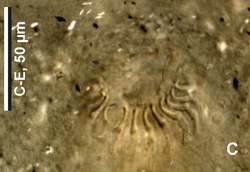Biology:Lethacotyle fijiensis
| Lethacotyle fijiensis | |
|---|---|
| File:Journal.pone.0079155.g002 cropped Lethacotyle fijiensis Manter & Prince, 1953, holotype body.tiff | |
| Holotype of Lethacotyle fijiensis Manter & Prince, 1953 | |
| Scientific classification | |
| Domain: | Eukaryota |
| Kingdom: | Animalia |
| Phylum: | Platyhelminthes |
| Class: | Monogenea |
| Order: | Mazocraeidea |
| Family: | Protomicrocotylidae |
| Genus: | Lethacotyle |
| Species: | L. fijiensis
|
| Binomial name | |
| Lethacotyle fijiensis Manter & Price, 1953
| |
Lethacotyle fijiensis is a species of monogeneans of the family Protomicrocotylidae.
The species is ectoparasitic on the gills of an unknown carangid fish identified in the original publication[1] as "yellow jack". It is the type-species of the genus Lethacotyle Manter & Prince, 1953. It has been described from two specimens only by Manter & Prince in 1953;[1] of these, a single specimen, the holotype has been kept in the US National Parasite Collections and thus was the single specimen of the species, and therefore of the genus, which was available for study. Later, another species of the same genus was described.[2]
Lethacotyle fijiensis has been found only off Fiji by Manter & Prince in 1953[1] (the material of the original description, hence the Latin species name, fijiensis, meaning "from Fiji") and allegedly off Andaman Islands by Ramalingam in 1968,[3][4] although other authors[2] have expressed doubt that the later author actually found the same species.
The two specimens of the original material of L. fijiensis are 3.156 and 3.759 millimetres in length.[1] The body is elongate, flat, there are numerous testes and a single ovary. The copulatory organs include a sclerotised vagina and male copulatory organ, comprising a ring of 24-25 spines which are 24 µm in length.[1] The length of the spines of the male copulatory apparatus is the main diagnosis character of the species,[2] which allows its separation from L. vera, the only other species of the genus.
The posterior part of the body of L. fijiensis is asymmetrical. It bears a terminal lappet which is striated, and there are no clamps - this is a characteristic of the genus Lethacotyle.[1][2]
References
- ↑ 1.0 1.1 1.2 1.3 1.4 1.5 Manter, H. W. & Prince, D. F. 1953: Some Monogenetic Trematodes of marine fishes from Fiji. Proceedings of the Helminthological Society of Washington, 20, 105-112.
- ↑ 2.0 2.1 2.2 2.3 "The Monogenean which lost its clamps". PLOS ONE 8 (11): e79155. 2013. doi:10.1371/journal.pone.0079155. PMID 24278118.
- ↑ Ramalingam, K. 1966: A rare record of Lethacotyle (Monogenea), its post-oncomiracidial larva with observation on distribution. Current Science, 35, 101-102.
- ↑ Ramalingam, K. 1968: A redescription of Lethacotyle (Monogenea) and its post-oncomiracidial larva. Journal of the Madras University B, 35-36, 107-114.
External links
| Wikimedia Commons has media related to Lethacotyle fijiensis. |
- Zoobank record for Lethacotyle fijiensis
- Gibson, D. (2013). Lethacotyle fijiensis Manter & Price, 1953. Accessed through: World Register of Marine Species at http://www.marinespecies.org/aphia.php?p=taxdetails&id=718228 on 2013-11-29
- Parasite of the day Blog: "Lethacotyle vera"
- PLoSONE Blog: "Fish beware: a new species of parasite is discovered"
Wikidata ☰ Q15279570 entry
 |



